Economics Assignment: Exploring Money Supply, Equilibrium, and Costs
VerifiedAdded on 2023/06/12
|8
|824
|470
Homework Assignment
AI Summary
This economics assignment delves into the intricacies of money market equilibrium, analyzing the relationship between money supply, interest rates, and aggregate demand. It examines how equilibrium is determined by the interaction of money demand and supply, with the central bank playing a crucial role in controlling money supply. The assignment further explores the impact of changes in money supply on interest rates, consumption, investment, and ultimately, the equilibrium price level and real GDP. Additionally, the assignment includes a cost analysis section, presenting data and cost curves to illustrate fixed, variable, and marginal costs associated with soap production. The document uses figures to support the explanations about money market and goods market equilibrium. Desklib provides access to similar solved assignments and past papers for students seeking further assistance.
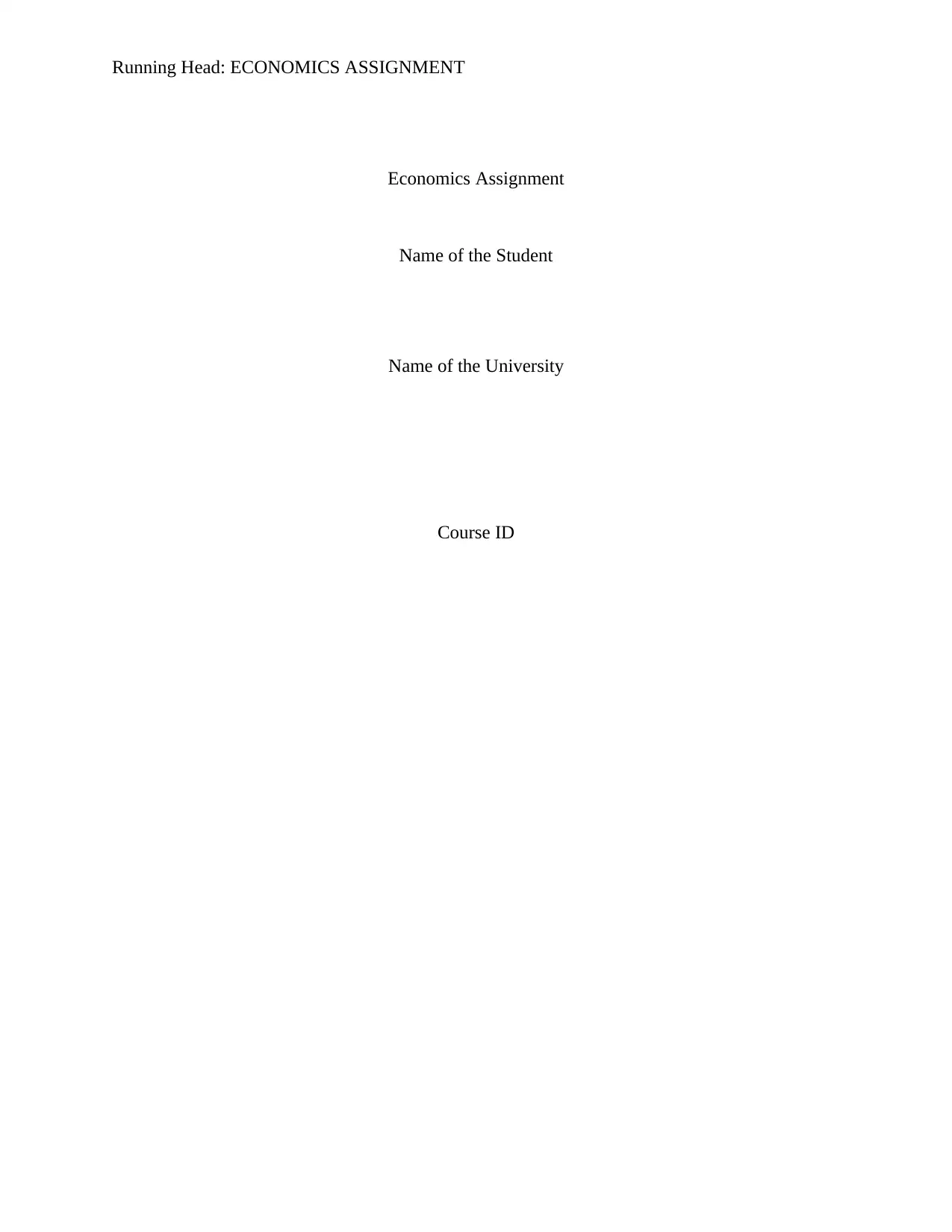
Running Head: ECONOMICS ASSIGNMENT
Economics Assignment
Name of the Student
Name of the University
Course ID
Economics Assignment
Name of the Student
Name of the University
Course ID
Paraphrase This Document
Need a fresh take? Get an instant paraphrase of this document with our AI Paraphraser
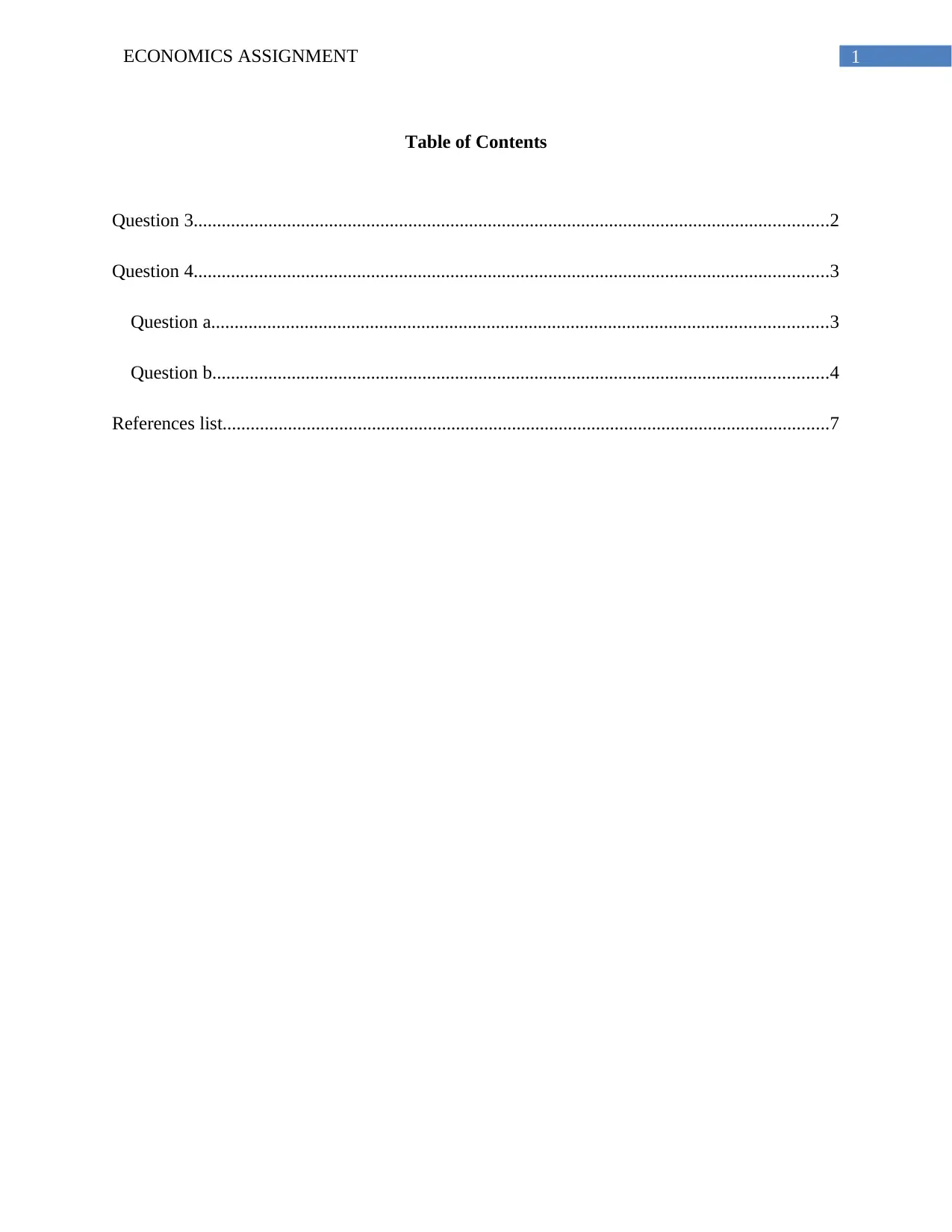
1ECONOMICS ASSIGNMENT
Table of Contents
Question 3........................................................................................................................................2
Question 4........................................................................................................................................3
Question a....................................................................................................................................3
Question b....................................................................................................................................4
References list..................................................................................................................................7
Table of Contents
Question 3........................................................................................................................................2
Question 4........................................................................................................................................3
Question a....................................................................................................................................3
Question b....................................................................................................................................4
References list..................................................................................................................................7
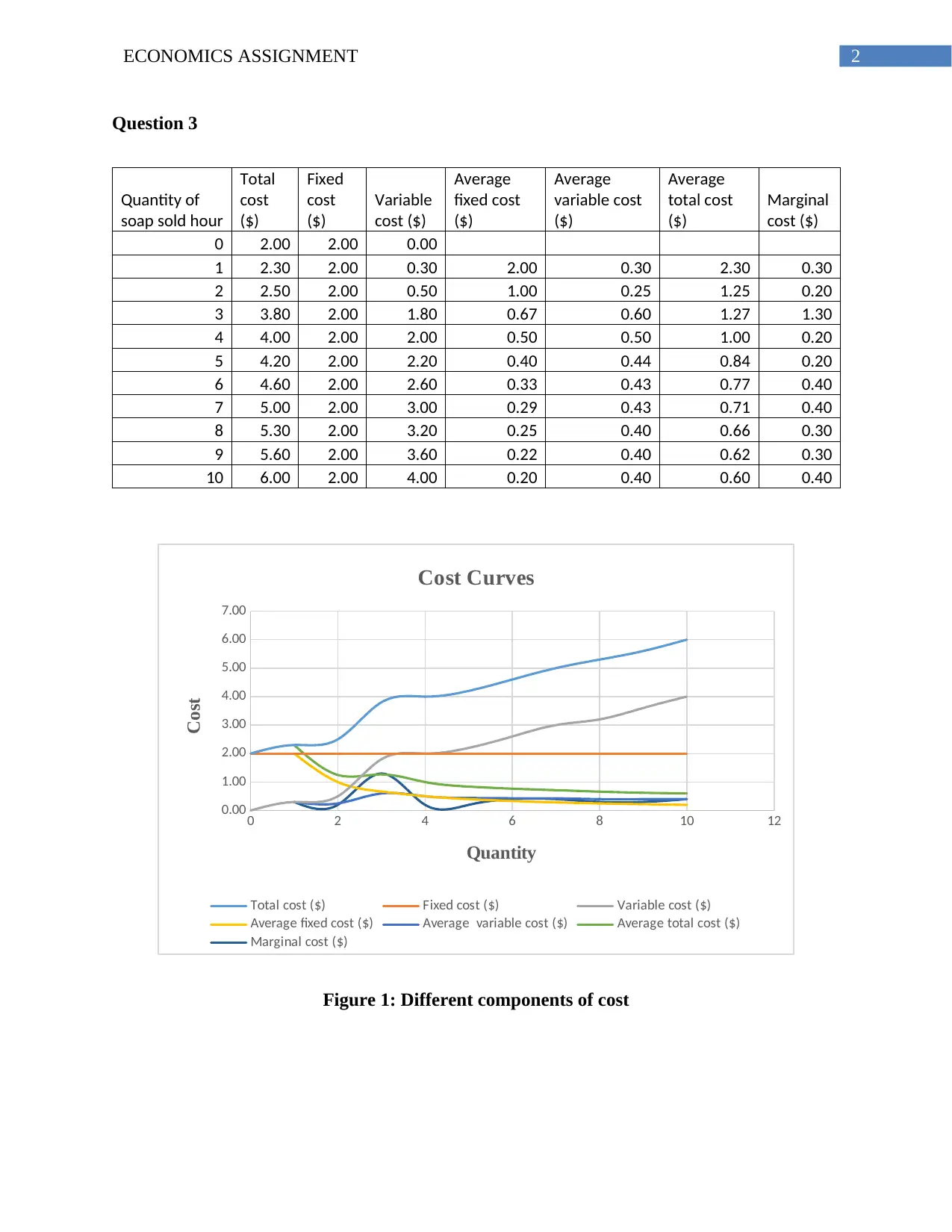
2ECONOMICS ASSIGNMENT
Question 3
Quantity of
soap sold hour
Total
cost
($)
Fixed
cost
($)
Variable
cost ($)
Average
fixed cost
($)
Average
variable cost
($)
Average
total cost
($)
Marginal
cost ($)
0 2.00 2.00 0.00
1 2.30 2.00 0.30 2.00 0.30 2.30 0.30
2 2.50 2.00 0.50 1.00 0.25 1.25 0.20
3 3.80 2.00 1.80 0.67 0.60 1.27 1.30
4 4.00 2.00 2.00 0.50 0.50 1.00 0.20
5 4.20 2.00 2.20 0.40 0.44 0.84 0.20
6 4.60 2.00 2.60 0.33 0.43 0.77 0.40
7 5.00 2.00 3.00 0.29 0.43 0.71 0.40
8 5.30 2.00 3.20 0.25 0.40 0.66 0.30
9 5.60 2.00 3.60 0.22 0.40 0.62 0.30
10 6.00 2.00 4.00 0.20 0.40 0.60 0.40
0 2 4 6 8 10 12
0.00
1.00
2.00
3.00
4.00
5.00
6.00
7.00
Cost Curves
Total cost ($) Fixed cost ($) Variable cost ($)
Average fixed cost ($) Average variable cost ($) Average total cost ($)
Marginal cost ($)
Quantity
Cost
Figure 1: Different components of cost
Question 3
Quantity of
soap sold hour
Total
cost
($)
Fixed
cost
($)
Variable
cost ($)
Average
fixed cost
($)
Average
variable cost
($)
Average
total cost
($)
Marginal
cost ($)
0 2.00 2.00 0.00
1 2.30 2.00 0.30 2.00 0.30 2.30 0.30
2 2.50 2.00 0.50 1.00 0.25 1.25 0.20
3 3.80 2.00 1.80 0.67 0.60 1.27 1.30
4 4.00 2.00 2.00 0.50 0.50 1.00 0.20
5 4.20 2.00 2.20 0.40 0.44 0.84 0.20
6 4.60 2.00 2.60 0.33 0.43 0.77 0.40
7 5.00 2.00 3.00 0.29 0.43 0.71 0.40
8 5.30 2.00 3.20 0.25 0.40 0.66 0.30
9 5.60 2.00 3.60 0.22 0.40 0.62 0.30
10 6.00 2.00 4.00 0.20 0.40 0.60 0.40
0 2 4 6 8 10 12
0.00
1.00
2.00
3.00
4.00
5.00
6.00
7.00
Cost Curves
Total cost ($) Fixed cost ($) Variable cost ($)
Average fixed cost ($) Average variable cost ($) Average total cost ($)
Marginal cost ($)
Quantity
Cost
Figure 1: Different components of cost
⊘ This is a preview!⊘
Do you want full access?
Subscribe today to unlock all pages.

Trusted by 1+ million students worldwide
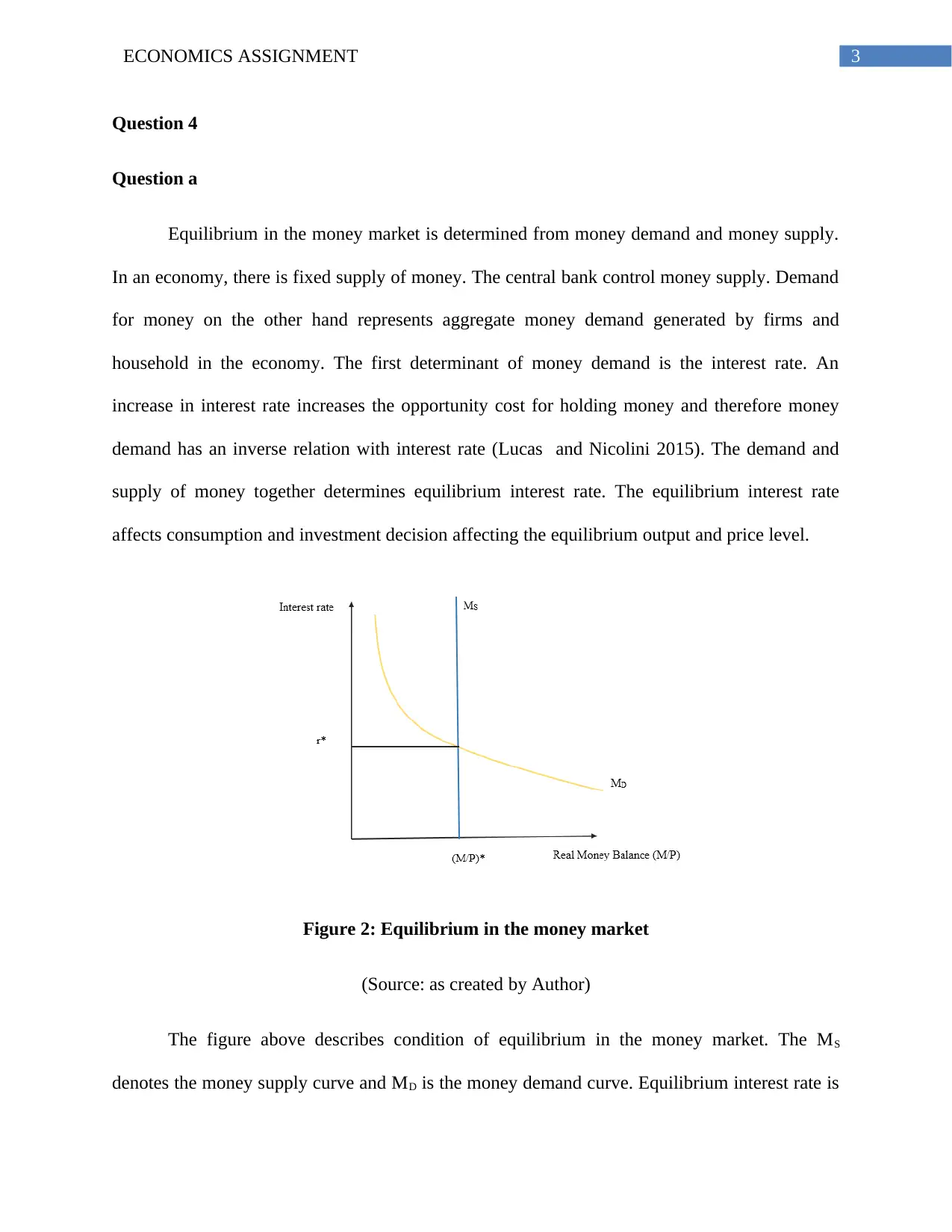
3ECONOMICS ASSIGNMENT
Question 4
Question a
Equilibrium in the money market is determined from money demand and money supply.
In an economy, there is fixed supply of money. The central bank control money supply. Demand
for money on the other hand represents aggregate money demand generated by firms and
household in the economy. The first determinant of money demand is the interest rate. An
increase in interest rate increases the opportunity cost for holding money and therefore money
demand has an inverse relation with interest rate (Lucas and Nicolini 2015). The demand and
supply of money together determines equilibrium interest rate. The equilibrium interest rate
affects consumption and investment decision affecting the equilibrium output and price level.
Figure 2: Equilibrium in the money market
(Source: as created by Author)
The figure above describes condition of equilibrium in the money market. The MS
denotes the money supply curve and MD is the money demand curve. Equilibrium interest rate is
Question 4
Question a
Equilibrium in the money market is determined from money demand and money supply.
In an economy, there is fixed supply of money. The central bank control money supply. Demand
for money on the other hand represents aggregate money demand generated by firms and
household in the economy. The first determinant of money demand is the interest rate. An
increase in interest rate increases the opportunity cost for holding money and therefore money
demand has an inverse relation with interest rate (Lucas and Nicolini 2015). The demand and
supply of money together determines equilibrium interest rate. The equilibrium interest rate
affects consumption and investment decision affecting the equilibrium output and price level.
Figure 2: Equilibrium in the money market
(Source: as created by Author)
The figure above describes condition of equilibrium in the money market. The MS
denotes the money supply curve and MD is the money demand curve. Equilibrium interest rate is
Paraphrase This Document
Need a fresh take? Get an instant paraphrase of this document with our AI Paraphraser
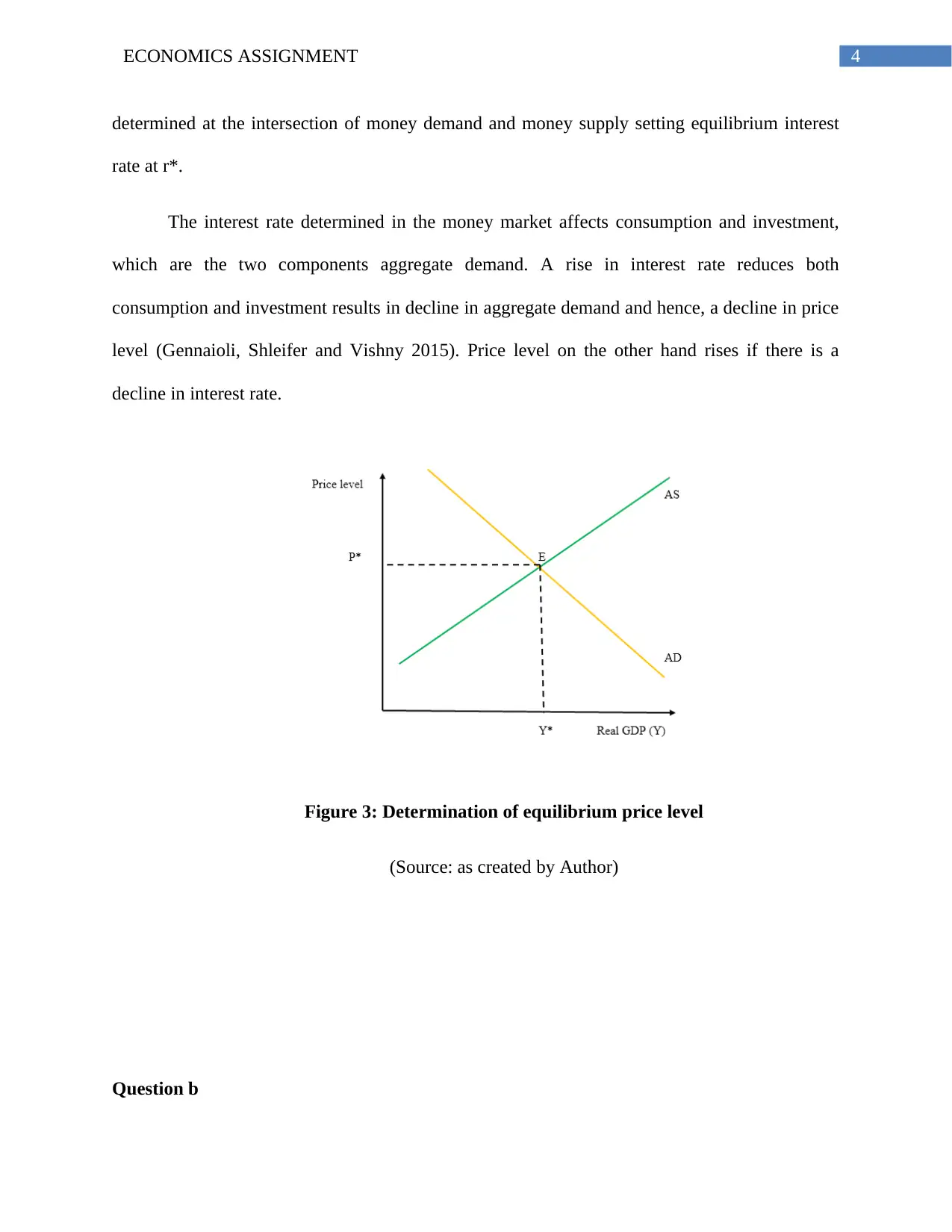
4ECONOMICS ASSIGNMENT
determined at the intersection of money demand and money supply setting equilibrium interest
rate at r*.
The interest rate determined in the money market affects consumption and investment,
which are the two components aggregate demand. A rise in interest rate reduces both
consumption and investment results in decline in aggregate demand and hence, a decline in price
level (Gennaioli, Shleifer and Vishny 2015). Price level on the other hand rises if there is a
decline in interest rate.
Figure 3: Determination of equilibrium price level
(Source: as created by Author)
Question b
determined at the intersection of money demand and money supply setting equilibrium interest
rate at r*.
The interest rate determined in the money market affects consumption and investment,
which are the two components aggregate demand. A rise in interest rate reduces both
consumption and investment results in decline in aggregate demand and hence, a decline in price
level (Gennaioli, Shleifer and Vishny 2015). Price level on the other hand rises if there is a
decline in interest rate.
Figure 3: Determination of equilibrium price level
(Source: as created by Author)
Question b
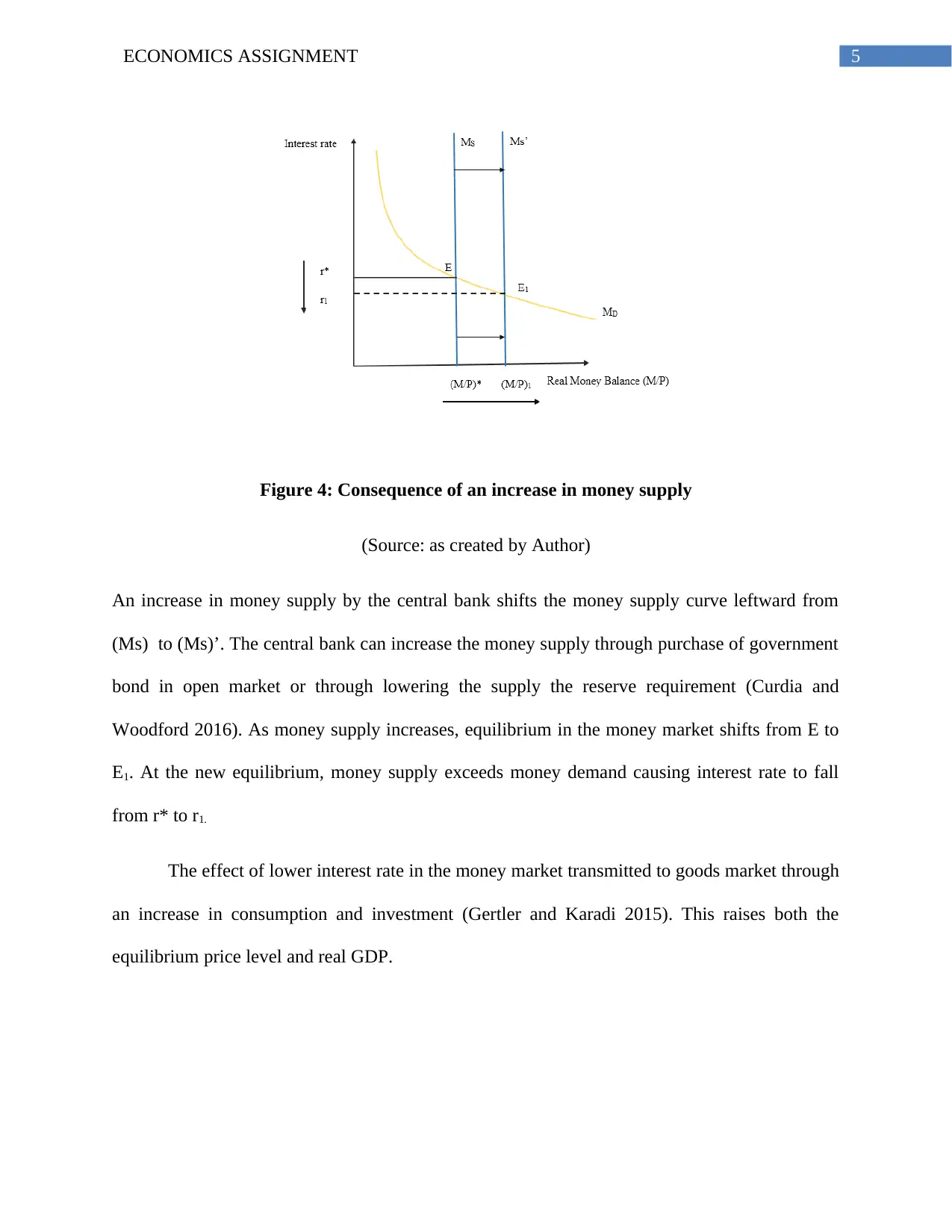
5ECONOMICS ASSIGNMENT
Figure 4: Consequence of an increase in money supply
(Source: as created by Author)
An increase in money supply by the central bank shifts the money supply curve leftward from
(Ms) to (Ms)’. The central bank can increase the money supply through purchase of government
bond in open market or through lowering the supply the reserve requirement (Curdia and
Woodford 2016). As money supply increases, equilibrium in the money market shifts from E to
E1. At the new equilibrium, money supply exceeds money demand causing interest rate to fall
from r* to r1.
The effect of lower interest rate in the money market transmitted to goods market through
an increase in consumption and investment (Gertler and Karadi 2015). This raises both the
equilibrium price level and real GDP.
Figure 4: Consequence of an increase in money supply
(Source: as created by Author)
An increase in money supply by the central bank shifts the money supply curve leftward from
(Ms) to (Ms)’. The central bank can increase the money supply through purchase of government
bond in open market or through lowering the supply the reserve requirement (Curdia and
Woodford 2016). As money supply increases, equilibrium in the money market shifts from E to
E1. At the new equilibrium, money supply exceeds money demand causing interest rate to fall
from r* to r1.
The effect of lower interest rate in the money market transmitted to goods market through
an increase in consumption and investment (Gertler and Karadi 2015). This raises both the
equilibrium price level and real GDP.
⊘ This is a preview!⊘
Do you want full access?
Subscribe today to unlock all pages.

Trusted by 1+ million students worldwide
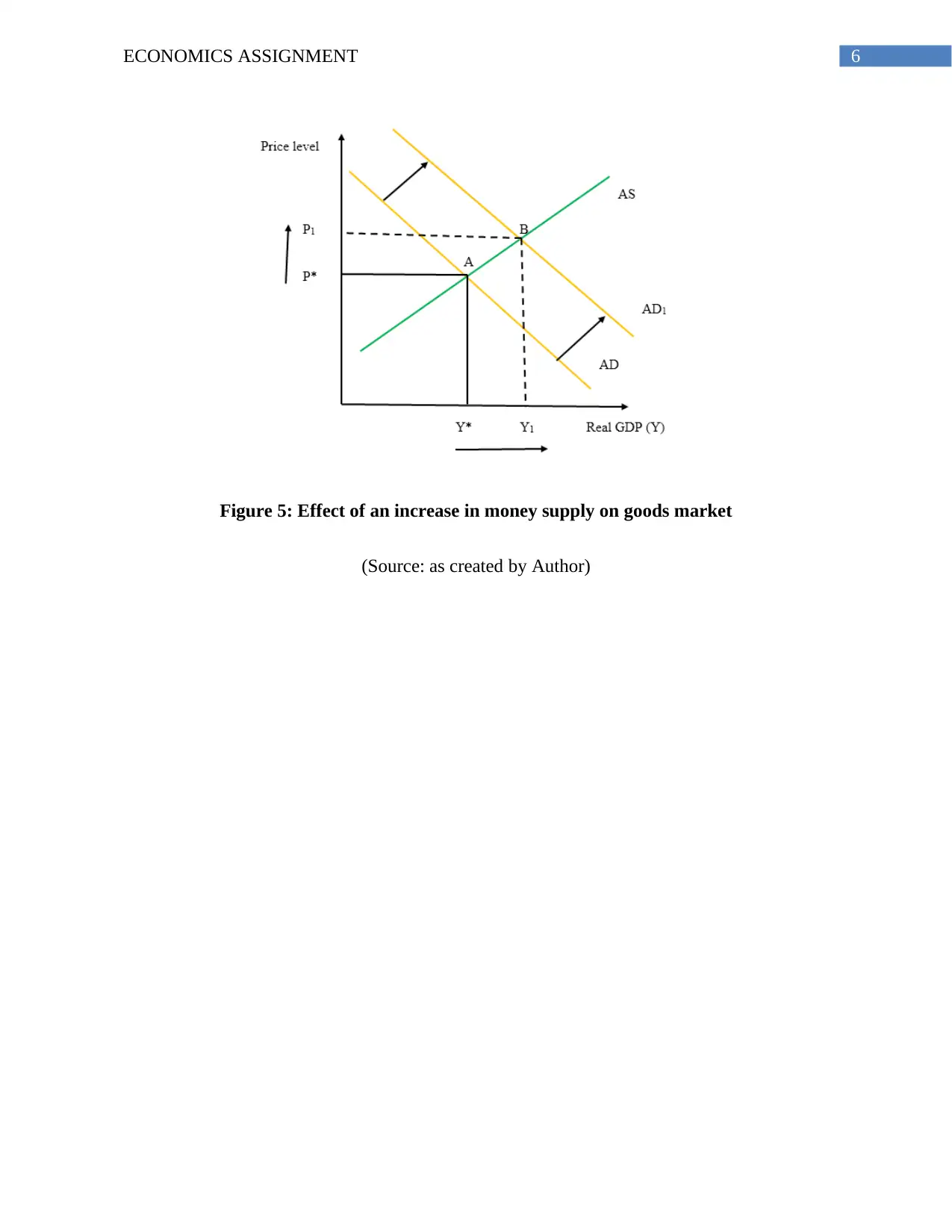
6ECONOMICS ASSIGNMENT
Figure 5: Effect of an increase in money supply on goods market
(Source: as created by Author)
Figure 5: Effect of an increase in money supply on goods market
(Source: as created by Author)
Paraphrase This Document
Need a fresh take? Get an instant paraphrase of this document with our AI Paraphraser
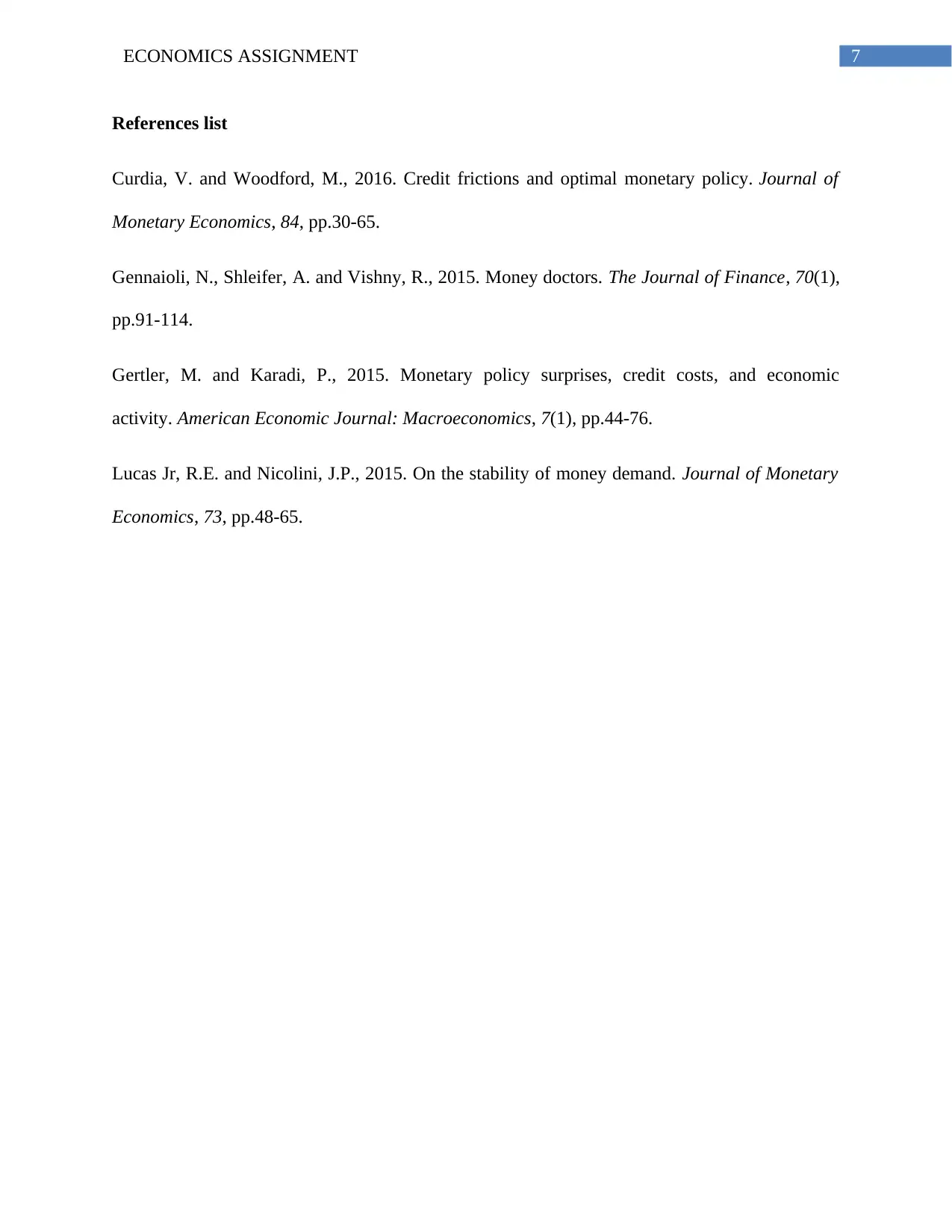
7ECONOMICS ASSIGNMENT
References list
Curdia, V. and Woodford, M., 2016. Credit frictions and optimal monetary policy. Journal of
Monetary Economics, 84, pp.30-65.
Gennaioli, N., Shleifer, A. and Vishny, R., 2015. Money doctors. The Journal of Finance, 70(1),
pp.91-114.
Gertler, M. and Karadi, P., 2015. Monetary policy surprises, credit costs, and economic
activity. American Economic Journal: Macroeconomics, 7(1), pp.44-76.
Lucas Jr, R.E. and Nicolini, J.P., 2015. On the stability of money demand. Journal of Monetary
Economics, 73, pp.48-65.
References list
Curdia, V. and Woodford, M., 2016. Credit frictions and optimal monetary policy. Journal of
Monetary Economics, 84, pp.30-65.
Gennaioli, N., Shleifer, A. and Vishny, R., 2015. Money doctors. The Journal of Finance, 70(1),
pp.91-114.
Gertler, M. and Karadi, P., 2015. Monetary policy surprises, credit costs, and economic
activity. American Economic Journal: Macroeconomics, 7(1), pp.44-76.
Lucas Jr, R.E. and Nicolini, J.P., 2015. On the stability of money demand. Journal of Monetary
Economics, 73, pp.48-65.
1 out of 8
Related Documents
Your All-in-One AI-Powered Toolkit for Academic Success.
+13062052269
info@desklib.com
Available 24*7 on WhatsApp / Email
![[object Object]](/_next/static/media/star-bottom.7253800d.svg)
Unlock your academic potential
Copyright © 2020–2025 A2Z Services. All Rights Reserved. Developed and managed by ZUCOL.





